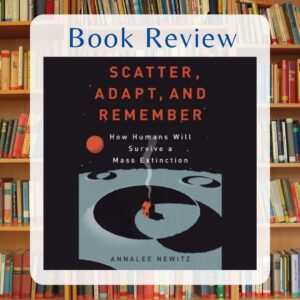
Scatter, Adapt and Remember: How Humans Will Survive a Mass Extinction
by Annalee Newitz
Book Review by Kristine Madera
 Part pop science, part muse for science fiction and other speculative writers, this gem of a book was a quick breeze through the various mass extinction events in Earth’s history, the promise that humans will face one or more of these events, and some hopeful wisdom on how we might weather the worst and survive as a species.
Part pop science, part muse for science fiction and other speculative writers, this gem of a book was a quick breeze through the various mass extinction events in Earth’s history, the promise that humans will face one or more of these events, and some hopeful wisdom on how we might weather the worst and survive as a species.
I read this as a speculative fiction writer interested in why a science writer puts so much stock into the imaginations of writers as vehicles for seeding new ideas and possibilities for humanity. Newitz sums up their book with the sentence: You’re always coming home but the path you take to get there is going to change all the time. In other words, humans are in a relentless quest to survive and thrive but we’d better learn to adapt quickly because life throws us curveballs all the time.
Scatter is a strategy used by diaspora communities, like Jewish immigrants, to spread their population widely and survive as a people. Humanity, as we propel ourselves into the space age, will only survive long-term as a species if we colonize other planets—and not just the ones in our own backyard. We also need to create massive moon-sized or larger spaceships to escape a dying Earth, hang out in space for long periods, and move mass populations to other galaxies.
Rapid adaptation is another human survival strategy. Newitz discusses how a massive volcano eruption, large asteroid, or nuclear apocalypse could drive humans underground for months or even decades to survive. This would require not only preparation but also the ability to grow food, access water, dispose of waste, and keep from killing each other from the stress of life underground. They present some interesting technological possibilities already underway that could help us survive and adapt to any number of extinction-level events.
Newitz, like other recent extinction-event writers, cautions about a worldwide pandemic and discusses technologies that could help us identify and mitigate pandemics in near real-time. They also talk about the technology of tsunamis and how to build coastal cities to survive them, the threat of planet-killing asteroids and the current and potential technologies that might nudge a killer asteroid onto a different track, and how to design and build living cities that bolster the infrastructure against the most obvious threats in a particular area like fires, floods, or mudslides.
The key to all of these (and so many survival strategies) is to remember what has happened in the past, realize that it could happen again, study what happened, build on survival strategies, and mitigate potential losses. The internet is key to holding long-term memories, as is information sharing across disciplines and the globe. This, of course, could be lost in a serious cataclysm without backup information-sharing strategies, networks, and power systems.
Like Newitz, I think way too much about how humanity might snuff it, and also like Newitz and other speculative and sci-fi writers, I do it so that I can imagine and write about ways that we as a species and a planet can weather our current challenges and thrive on the other side. Newitz helps that quest by presenting both past problems along with current possible and theoretical solutions on the path to what they state more than once as our ultimate survival strategy—to become a space-faring species colonizing multiple planets and star systems.
Terrific read, especially for SFF writers! Oh, and did I mention that Newitz is a stellar Sci-Fi writer, too? Now you know!
Imagineering Protopia
Earth has been in an unusually stable climate and environmental period for about the last 10,000 years. But in the geologic and climate record, Earth is a roller coaster, even without human-related environmental impacts. Humans also tend to minimize the capacity for change—both good and bad, but mostly we don’t think the very bad can happen, whether pandemics, financial or housing crashes, famines in wealthy nations, or catastrophic events like major asteroid impacts. Yet all of these things have, and likely will again.
Newitz focuses on how technology can improve the chance of surviving (as a species) a major catastrophic event. I generally focus on human thinking, the systems we create from our thoughts, ideas, and beliefs, and how these increase or decrease our odds of survival as a species.
Humans have almost died out many times. Civilizations have risen and fallen. The falls and near extinctions have wiped out learning and technology—think the Giza Pyramids, Mayan Temples, and Sumerian Society—and thrust people back to a simpler, more day-to-day survival life. Previous civilizations that fell or died out for some (possibly cataclysmic) reason, were, as far as we know now, not interdependent as a global system, and had hundreds of thousands or millions and not billions of interdependent people and systems. We can see the remnants of these civilizations but, because the technology around writing, record-keeping, and knowledge-storage was lost during or soon after the fall, the records of the falls and what happened afterward are largely lost.
How might that look on our planet today, where most of humanity is dependent on collective food, power, water, and transportation systems? Mad Max, anyone?
Some cultures are more legacy-focused than others—planning and creating in terms of decades or centuries rather than quarterly statements or election cycles. But these legacy-thinkers are generally confined to their national/political, technological, and/or economic systems. This is more helpful and hopeful than the Prepper mindset of short-term (months/years), individual/group physical/economic survival, but it still falls short of what we could build as a species if we shifted our thinking from short-term individual interests to long-term, cooperative planning for thriving now while also creating systems that support thriving centuries from now.
The ability to use technology the way Newitz discusses requires this kind of long-range thinking and creating. One thing the Covid pandemic taught us is the cost in both dollars and lives of having no streamlined, reliable response system, neither as individual nations nor as a global community. Covid turned out to be not as bad as it first appeared, but what if it had been a deadly novel flu, or an anti-biotic resistant plague, or a debilitating fungal or microbial infection that killed or incapacitated 25% of the population? Would our supply chains, agricultural and/or power infrastructures, and medical systems have survived? Probably not. On the heels of even one of these systems collapsing would have been governments and civil society in general.
Civilization is the functional running of civilized society, which itself is held together by a thin thread that could easily unravel. We could make it much. More robust by shifting the oneupmanship, winner-take-all, power-and-profit-at-all-cost incentives that dominate global systems now. Not only are they wasteful in the sense that so many efforts and production systems are duplicated and that products are designed to fail to boost profits, but they hold us back as a species. How could we incentivize open systems that explore and bring to reality zero-point or some other decentralized, non-polluting, on-demand, unlimited energy system and make it universally available? With unlimited energy, computing power could skyrocket and we could (with the right incentives) use it to solve the technical challenges to having eight billion plus people thriving on our planet and work together to expand into a space-living species as well.
What this takes is a shift in thinking and decision-making, along with incentives that move us from a defensive survival mode of each person fretting and fighting about how to get enough resources to support their individual 80- or 90-year lifespan, to a thriving mode where everyone can participate, access the resources they need to live a comfortable life, and use their vast human creativity in helpful, fun, and interesting ways.

About Kristine
Kristine Madera is a #1 bestselling Amazon author, novelist, hypnotherapist, and pro-topian with a passion for helping people better themselves and the world. Informed by global travel, teaching abroad, and a stint as a Peace Corps Volunteer, Kristine believes that everyone plays a part in imagining and creating our collective future.
Volunteering at Mother Teresa’s Home for the Dying in Calcutta inspired her novel, God in Drag. She birthed her upcoming novel, The Snakeman’s Wife, as a Peace Corps Volunteer in Papua New Guinea.
Read the first chapter of God in Drag HERE
